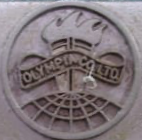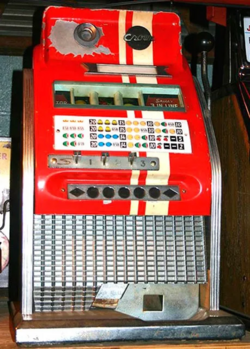Difference between revisions of "Olympia (company)"
From Sega Retro
m (→Company: clarification) |
m (→Company) |
||
| Line 17: | Line 17: | ||
Taito launched its new token-equipped ''Royal Crown'' into the Japanese market that year. However, immediately after their breakthrough, Taito caught wind that [[Sega Enterprises]] were about to launch an identical product with an identical token system.{{ref|1=https://blog.goo.ne.jp/nazox2016/e/71646fc259602a59deb9707332200cd4?fm=entry_awc}} An upset Taito then made its grievances known throughout the industry, which eventually culminated in a meeting between the two. While the exact details of this meeting are unknown, it is speculated that Sega used the fact that the ''Royal Crown'' was a clone of their ''[[Sega Bell]]'' to leverage a position in their favor.{{ref|1=https://blog.goo.ne.jp/nazox2016/e/71646fc259602a59deb9707332200cd4?fm=entry_awc}} Ultimately, the two companies settled on a compromise. | Taito launched its new token-equipped ''Royal Crown'' into the Japanese market that year. However, immediately after their breakthrough, Taito caught wind that [[Sega Enterprises]] were about to launch an identical product with an identical token system.{{ref|1=https://blog.goo.ne.jp/nazox2016/e/71646fc259602a59deb9707332200cd4?fm=entry_awc}} An upset Taito then made its grievances known throughout the industry, which eventually culminated in a meeting between the two. While the exact details of this meeting are unknown, it is speculated that Sega used the fact that the ''Royal Crown'' was a clone of their ''[[Sega Bell]]'' to leverage a position in their favor.{{ref|1=https://blog.goo.ne.jp/nazox2016/e/71646fc259602a59deb9707332200cd4?fm=entry_awc}} Ultimately, the two companies settled on a compromise. | ||
| − | Olympia Co., Ltd. (a name created by [[Taito]] to capitalize on Tokyo's [[wikipedia:1964 Summer Olympics|1964 Summer Olympics]]) was officially established in 1964 as a special joint venture between Sega Enterprises and Taito.{{ref|1=https://blog.goo.ne.jp/nazox2016/e/f43ea93334695ed0ff036c2916b2a5be?fm=entry_awc}} It was agreed upon that Sega would manufacture the new machines and Taito would handle their sales and marketing{{ref|1=https://blog.goo.ne.jp/nazox2016/e/f43ea93334695ed0ff036c2916b2a5be?fm=entry_awc}}; the end result would be the ''[[Olympia Star]]'', released that same year. Although this new type of slot machine (dubbed ''Olympia Machines'' by the Japanese public{{ref|https://blog.goo.ne.jp/nazox2016/e/d2691f40123ae387fedcc2b567659706}}) was intended to be published only through Olympia Co., Ltd., both Sega and Taito participated in selling their own unique versions of the machine for the next decade.{{ref|1=https://blog.goo.ne.jp/nazox2016/e/48f4b03c1f524aad673d296569deba4b?fm=entry_awc}} | + | Olympia Co., Ltd. (a name created by [[Taito]] to capitalize on Tokyo's [[wikipedia:1964 Summer Olympics|1964 Summer Olympics]]) was officially established in 1964 as a special joint venture between Sega Enterprises and Taito.{{ref|1=https://blog.goo.ne.jp/nazox2016/e/f43ea93334695ed0ff036c2916b2a5be?fm=entry_awc}} It was agreed upon that Sega would manufacture the new machines and Taito would handle their sales and marketing{{ref|1=https://blog.goo.ne.jp/nazox2016/e/f43ea93334695ed0ff036c2916b2a5be?fm=entry_awc}}; the end result would be the ''[[Olympia Star]]'', released that same year. Although this new type of slot machine (dubbed ''"Olympia Machines"'' by the Japanese public{{ref|https://blog.goo.ne.jp/nazox2016/e/d2691f40123ae387fedcc2b567659706}}) was intended to be published only through Olympia Co., Ltd., both Sega and Taito participated in selling their own unique versions of the machine for the next decade.{{ref|1=https://blog.goo.ne.jp/nazox2016/e/48f4b03c1f524aad673d296569deba4b?fm=entry_awc}} |
Olympia would continue to publish four further ''Olympia'' machines. Known as the [[Olympia series|''Olympia'' series]], these machines were produced up until at least 1974. The Olympia logo, fittingly inspired by the [[wikipedia:Olympic flame|Olympic flame]], appears emblazoned on every officially-licensed slot machine in the series. | Olympia would continue to publish four further ''Olympia'' machines. Known as the [[Olympia series|''Olympia'' series]], these machines were produced up until at least 1974. The Olympia logo, fittingly inspired by the [[wikipedia:Olympic flame|Olympic flame]], appears emblazoned on every officially-licensed slot machine in the series. | ||
Revision as of 01:03, 30 August 2023
- For the unrelated pachinko manufacturer, see Olympia (pachinko company).
Olympia Co., Ltd. (株式会社オリンピア), was a joint venture established by Sega Enterprises and Taito to manufacture and sell the Olympia Star slot machine, bringing a form of legalized slot gambling to Japan and laying the foundations for the future medal game industry.[1]
The company is unrelated to Olympia, the Japanese pachinko manufacturer.[1]
Company
Around 1960, Taito was struggling to sell its new Royal Crown[2] slot machine in gambling-legal territories. The machine, a substantial copy of the Sega Bell[3], was built to the same specifications as Sega's machine, but failed to achieve the same market penetration. This forced the company to examine alternatives to the traditional slot machine market, and their attention turned to Japan. Gambling is largely illegal in Japan, but Taito envisioned a system in which the gambling was done through tokens; these tokens would later be exchanged for real money through a separate process. Such a project to introduce gambling to Japan had been previously attempted in 1951 and later rejected[4], so Taito took an additional step in differentiating their system by including a stop button on each of the three reels - this was framed as adding a skill-based element to the game.[4] Importantly, the new Royal Crown would be officially categorized as a "sex industry sales machine" to further distance itself from the slot machine market.[4] Regardless, when the company somehow managed to actually acquire permission from authorities to produce the machine in 1964, the industry was shocked.[1]
Taito launched its new token-equipped Royal Crown into the Japanese market that year. However, immediately after their breakthrough, Taito caught wind that Sega Enterprises were about to launch an identical product with an identical token system.[4] An upset Taito then made its grievances known throughout the industry, which eventually culminated in a meeting between the two. While the exact details of this meeting are unknown, it is speculated that Sega used the fact that the Royal Crown was a clone of their Sega Bell to leverage a position in their favor.[4] Ultimately, the two companies settled on a compromise.
Olympia Co., Ltd. (a name created by Taito to capitalize on Tokyo's 1964 Summer Olympics) was officially established in 1964 as a special joint venture between Sega Enterprises and Taito.[5] It was agreed upon that Sega would manufacture the new machines and Taito would handle their sales and marketing[5]; the end result would be the Olympia Star, released that same year. Although this new type of slot machine (dubbed "Olympia Machines" by the Japanese public[1]) was intended to be published only through Olympia Co., Ltd., both Sega and Taito participated in selling their own unique versions of the machine for the next decade.[6]
Olympia would continue to publish four further Olympia machines. Known as the Olympia series, these machines were produced up until at least 1974. The Olympia logo, fittingly inspired by the Olympic flame, appears emblazoned on every officially-licensed slot machine in the series.
Softography
Slot machine
- Olympia Star (1964)
- New Olympia (1969)
- Olympia Mark II (1971)
- Olympia Mark III (1972)
- Olympia Golden Star (1974)
External links
- The mystery of the origin of a Pachislot called Olympia article at Old gamer's memory of arcade games and its surroundings (Japanese)
References
- ↑ 1.0 1.1 1.2 1.3 1.4 https://blog.goo.ne.jp/nazox2016/e/d2691f40123ae387fedcc2b567659706
- ↑ https://blog.goo.ne.jp/nazox2016/e/22190e8b53d96394e4843317cc6932eb?fm=entry_awc
- ↑ https://blog.goo.ne.jp/nazox2016/e/b22374a6326a861ea15242c6d6eca004?fm=entry_awc
- ↑ 4.0 4.1 4.2 4.3 4.4 https://blog.goo.ne.jp/nazox2016/e/71646fc259602a59deb9707332200cd4?fm=entry_awc
- ↑ 5.0 5.1 https://blog.goo.ne.jp/nazox2016/e/f43ea93334695ed0ff036c2916b2a5be?fm=entry_awc
- ↑ https://blog.goo.ne.jp/nazox2016/e/48f4b03c1f524aad673d296569deba4b?fm=entry_awc

